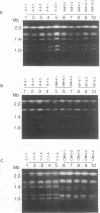Abstract
Candida yeasts are occasionally recovered from patients with leukemia in spite of antifungal therapy used during chemotherapy. It is not yet known whether yeasts in these patients are of endogenous or exogenous origin. We examined the strain relatedness of Candida albicans isolated from three patients with leukemia (A, B, and C) and their bedside parents using pulsed-field gel electrophoresis (PFGE), restriction fragment length polymorphism (RFLP) by SmaI digestion, and the Southern hybridization patterns of the RFLPs by the C. albicans-specific probe RPS1. SmaI digestion and Southern hybridization by RPS1 showed identical or similar patterns among Candida isolates in patients A and his mother, although their karyotypes were different. Isolates from patients B and both parents showed identical electrophoretic karyotypes, SmaI digestion patterns, and hybridization patterns. Since electrophoretic karyotypes are more variable than RFLPs and their hybridization patterns, the identity of the last two suggests a close relatedness between strains. Our results also suggest that transmission of yeast strains may have occurred between patient A and his mother and between patient B and her parents. Isolates from patient C and her mother are thought to have originated from different strains, since different patterns were obtained in electrophoretic karyotypes, SmaI digestion patterns, and Southern hybridization patterns.
Full text
PDF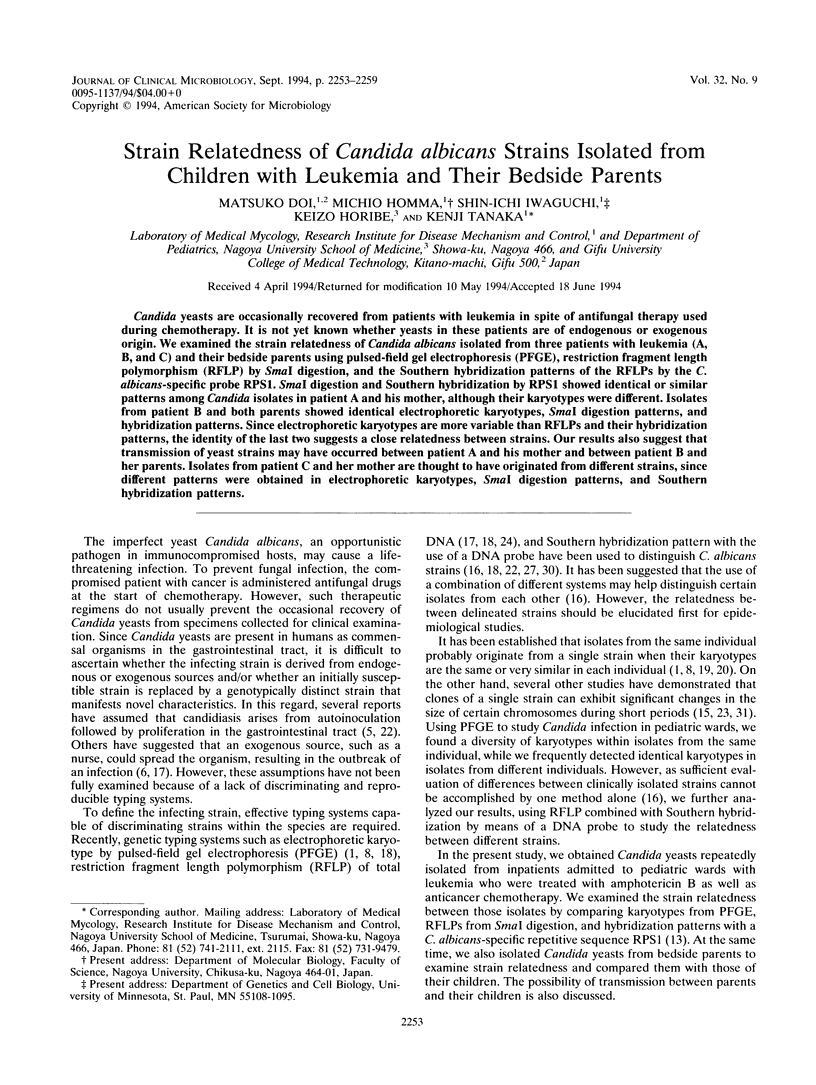
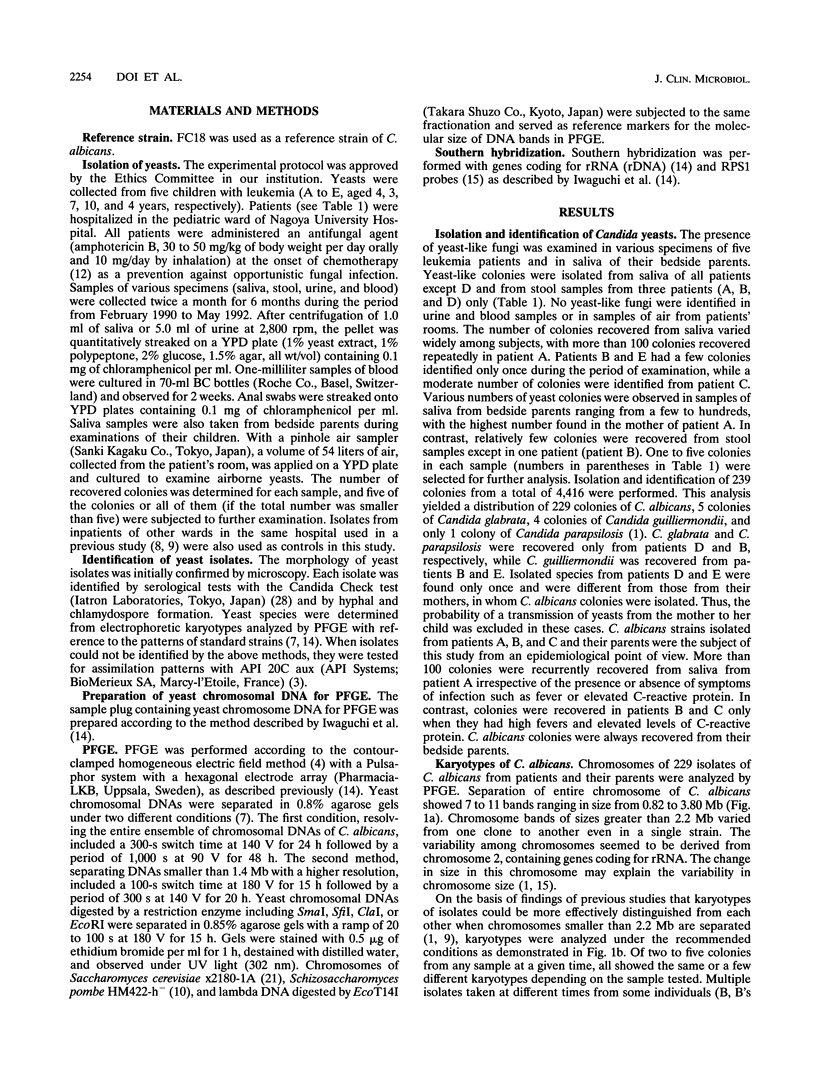
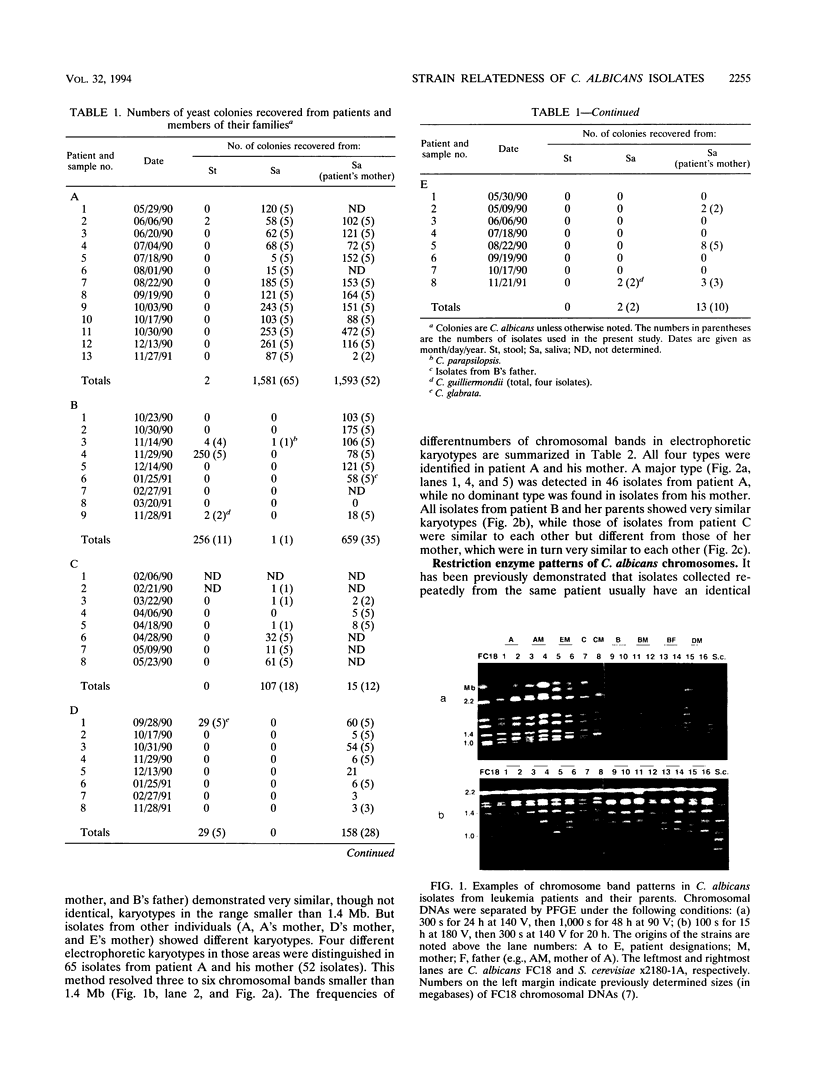
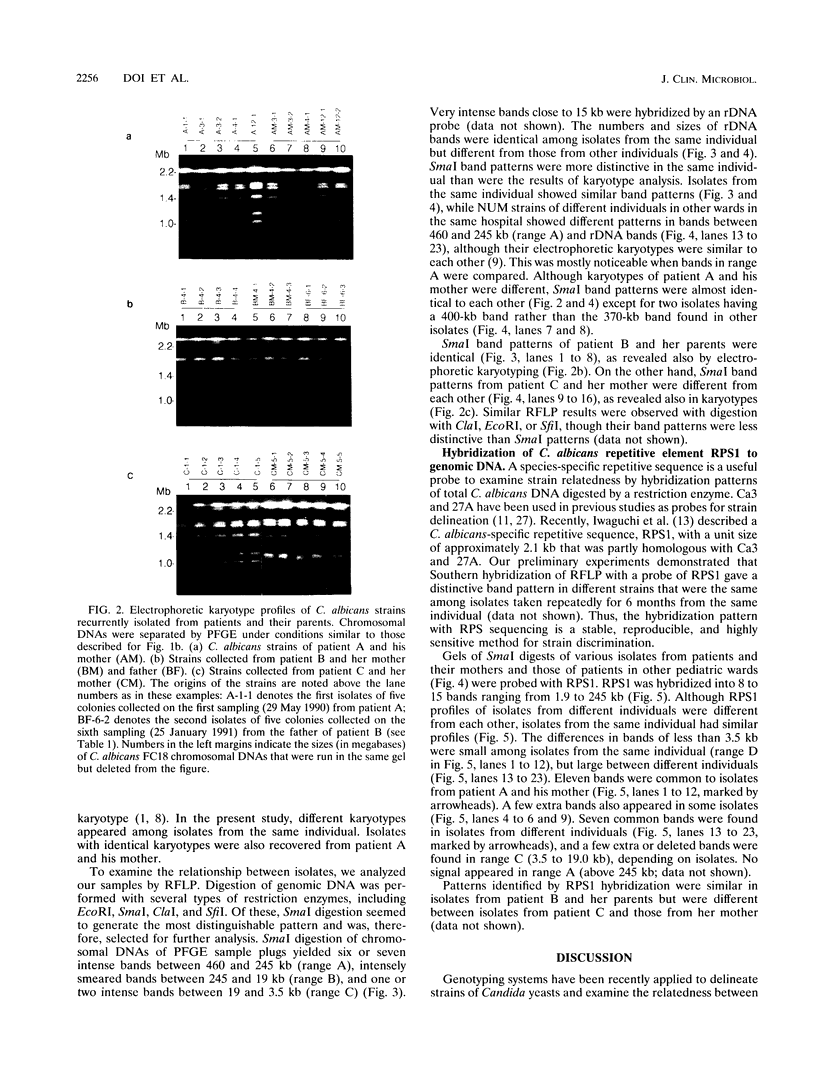
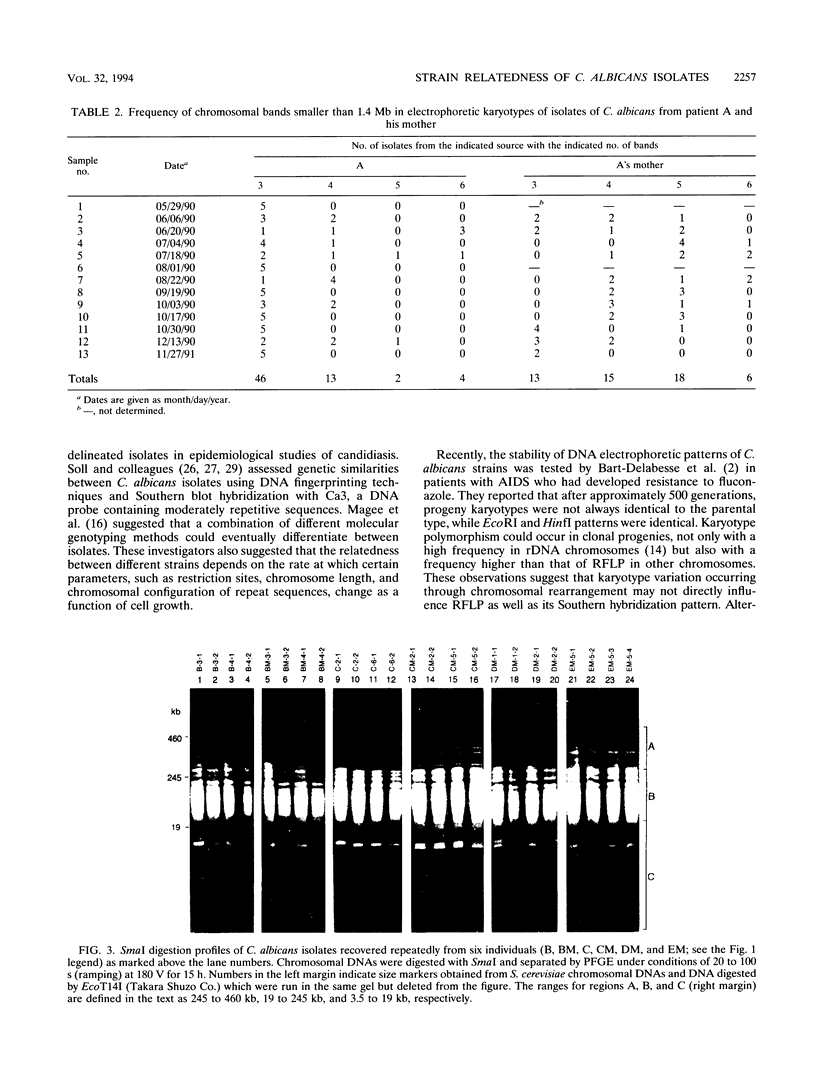
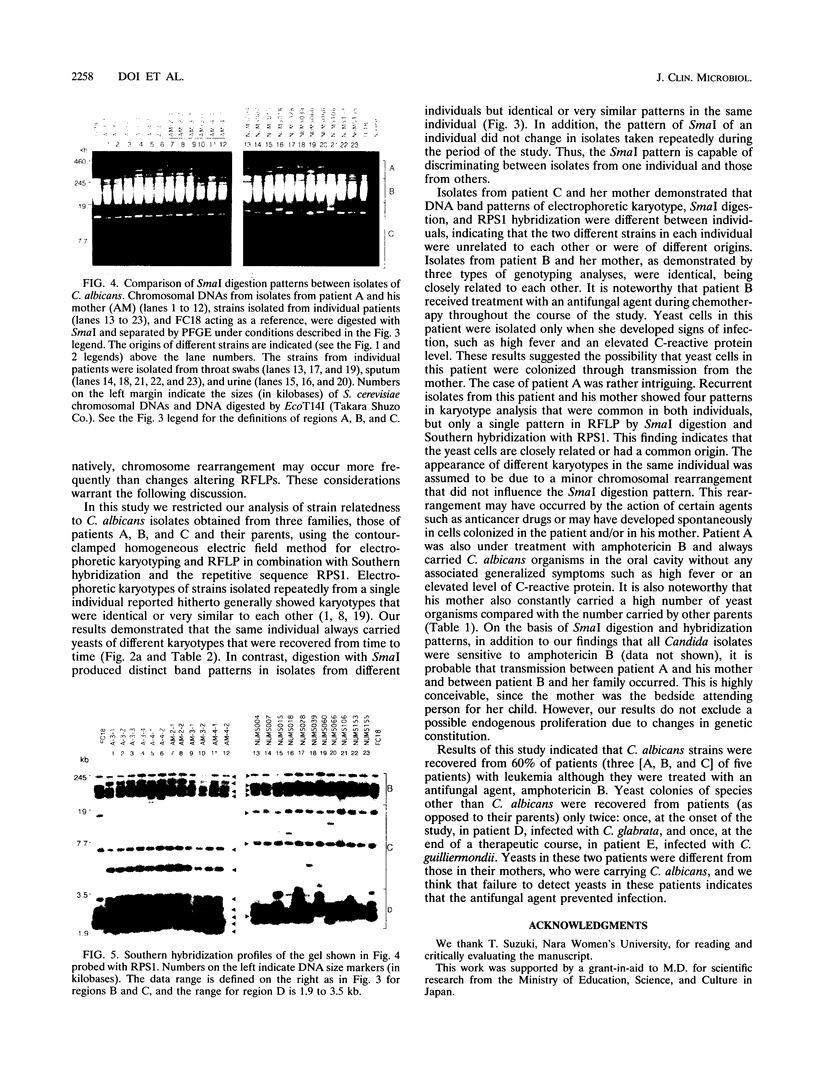
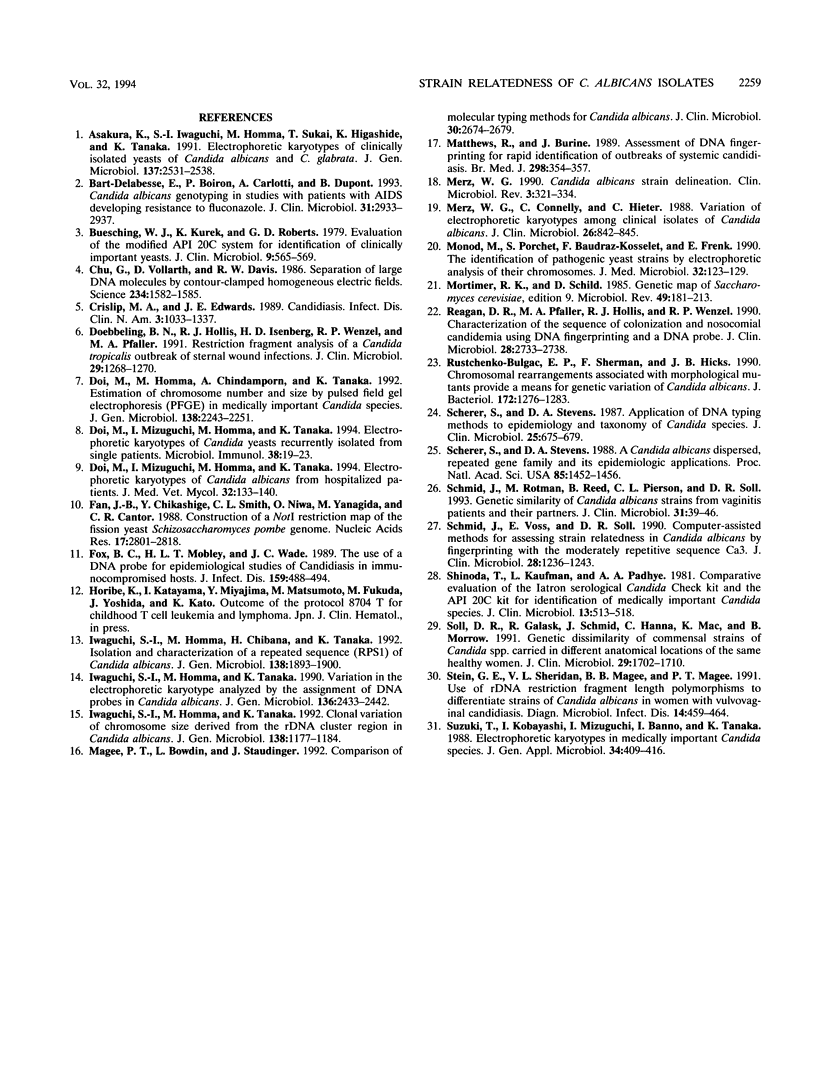
Images in this article
Selected References
These references are in PubMed. This may not be the complete list of references from this article.
- Asakura K., Iwaguchi S., Homma M., Sukai T., Higashide K., Tanaka K. Electrophoretic karyotypes of clinically isolated yeasts of Candida albicans and C. glabrata. J Gen Microbiol. 1991 Nov;137(11):2531–2538. doi: 10.1099/00221287-137-11-2531. [DOI] [PubMed] [Google Scholar]
- Bart-Delabesse E., Boiron P., Carlotti A., Dupont B. Candida albicans genotyping in studies with patients with AIDS developing resistance to fluconazole. J Clin Microbiol. 1993 Nov;31(11):2933–2937. doi: 10.1128/jcm.31.11.2933-2937.1993. [DOI] [PMC free article] [PubMed] [Google Scholar]
- Buesching W. J., Kurek K., Roberts G. D. Evaluation of the modified API 20C system for identification of clinically important yeasts. J Clin Microbiol. 1979 May;9(5):565–569. doi: 10.1128/jcm.9.5.565-569.1979. [DOI] [PMC free article] [PubMed] [Google Scholar]
- Chu G., Vollrath D., Davis R. W. Separation of large DNA molecules by contour-clamped homogeneous electric fields. Science. 1986 Dec 19;234(4783):1582–1585. doi: 10.1126/science.3538420. [DOI] [PubMed] [Google Scholar]
- Doebbeling B. N., Hollis R. J., Isenberg H. D., Wenzel R. P., Pfaller M. A. Restriction fragment analysis of a Candida tropicalis outbreak of sternal wound infections. J Clin Microbiol. 1991 Jun;29(6):1268–1270. doi: 10.1128/jcm.29.6.1268-1270.1991. [DOI] [PMC free article] [PubMed] [Google Scholar]
- Doi M., Homma M., Chindamporn A., Tanaka K. Estimation of chromosome number and size by pulsed-field gel electrophoresis (PFGE) in medically important Candida species. J Gen Microbiol. 1992 Oct;138(10):2243–2251. doi: 10.1099/00221287-138-10-2243. [DOI] [PubMed] [Google Scholar]
- Doi M., Mizuguchi I., Homma M., Tanaka K. Electrophoretic karyotypes of Candida yeasts recurrently isolated from single patients. Microbiol Immunol. 1994;38(1):19–23. doi: 10.1111/j.1348-0421.1994.tb01739.x. [DOI] [PubMed] [Google Scholar]
- Doi M., Mizuguchi I., Homma M., Tanaka K. Electrophoretic karyotypes of isolates of Candida albicans from hospitalized patients. J Med Vet Mycol. 1994;32(2):133–140. [PubMed] [Google Scholar]
- Fan J. B., Chikashige Y., Smith C. L., Niwa O., Yanagida M., Cantor C. R. Construction of a Not I restriction map of the fission yeast Schizosaccharomyces pombe genome. Nucleic Acids Res. 1989 Apr 11;17(7):2801–2818. doi: 10.1093/nar/17.7.2801. [DOI] [PMC free article] [PubMed] [Google Scholar]
- Fox B. C., Mobley H. L., Wade J. C. The use of a DNA probe for epidemiological studies of candidiasis in immunocompromised hosts. J Infect Dis. 1989 Mar;159(3):488–494. doi: 10.1093/infdis/159.3.488. [DOI] [PubMed] [Google Scholar]
- Iwaguchi S., Homma M., Chibana H., Tanaka K. Isolation and characterization of a repeated sequence (RPS1) of Candida albicans. J Gen Microbiol. 1992 Sep;138(9):1893–1900. doi: 10.1099/00221287-138-9-1893. [DOI] [PubMed] [Google Scholar]
- Iwaguchi S., Homma M., Tanaka K. Clonal variation of chromosome size derived from the rDNA cluster region in Candida albicans. J Gen Microbiol. 1992 Jun;138(6):1177–1184. doi: 10.1099/00221287-138-6-1177. [DOI] [PubMed] [Google Scholar]
- Iwaguchi S., Homma M., Tanaka K. Variation in the electrophoretic karyotype analysed by the assignment of DNA probes in Candida albicans. J Gen Microbiol. 1990 Dec;136(12):2433–2442. doi: 10.1099/00221287-136-12-2433. [DOI] [PubMed] [Google Scholar]
- Magee P. T., Bowdin L., Staudinger J. Comparison of molecular typing methods for Candida albicans. J Clin Microbiol. 1992 Oct;30(10):2674–2679. doi: 10.1128/jcm.30.10.2674-2679.1992. [DOI] [PMC free article] [PubMed] [Google Scholar]
- Matthews R., Burnie J. Assessment of DNA fingerprinting for rapid identification of outbreaks of systemic candidiasis. BMJ. 1989 Feb 11;298(6670):354–357. doi: 10.1136/bmj.298.6670.354. [DOI] [PMC free article] [PubMed] [Google Scholar]
- Merz W. G. Candida albicans strain delineation. Clin Microbiol Rev. 1990 Oct;3(4):321–334. doi: 10.1128/cmr.3.4.321. [DOI] [PMC free article] [PubMed] [Google Scholar]
- Merz W. G., Connelly C., Hieter P. Variation of electrophoretic karyotypes among clinical isolates of Candida albicans. J Clin Microbiol. 1988 May;26(5):842–845. doi: 10.1128/jcm.26.5.842-845.1988. [DOI] [PMC free article] [PubMed] [Google Scholar]
- Monod M., Porchet S., Baudraz-Rosselet F., Frenk E. The identification of pathogenic yeast strains by electrophoretic analysis of their chromosomes. J Med Microbiol. 1990 Jun;32(2):123–129. doi: 10.1099/00222615-32-2-123. [DOI] [PubMed] [Google Scholar]
- Mortimer R. K., Schild D. Genetic map of Saccharomyces cerevisiae, edition 9. Microbiol Rev. 1985 Sep;49(3):181–213. doi: 10.1128/mr.49.3.181-213.1985. [DOI] [PMC free article] [PubMed] [Google Scholar]
- Reagan D. R., Pfaller M. A., Hollis R. J., Wenzel R. P. Characterization of the sequence of colonization and nosocomial candidemia using DNA fingerprinting and a DNA probe. J Clin Microbiol. 1990 Dec;28(12):2733–2738. doi: 10.1128/jcm.28.12.2733-2738.1990. [DOI] [PMC free article] [PubMed] [Google Scholar]
- Rustchenko-Bulgac E. P., Sherman F., Hicks J. B. Chromosomal rearrangements associated with morphological mutants provide a means for genetic variation of Candida albicans. J Bacteriol. 1990 Mar;172(3):1276–1283. doi: 10.1128/jb.172.3.1276-1283.1990. [DOI] [PMC free article] [PubMed] [Google Scholar]
- Scherer S., Stevens D. A. A Candida albicans dispersed, repeated gene family and its epidemiologic applications. Proc Natl Acad Sci U S A. 1988 Mar;85(5):1452–1456. doi: 10.1073/pnas.85.5.1452. [DOI] [PMC free article] [PubMed] [Google Scholar]
- Scherer S., Stevens D. A. Application of DNA typing methods to epidemiology and taxonomy of Candida species. J Clin Microbiol. 1987 Apr;25(4):675–679. doi: 10.1128/jcm.25.4.675-679.1987. [DOI] [PMC free article] [PubMed] [Google Scholar]
- Schmid J., Rotman M., Reed B., Pierson C. L., Soll D. R. Genetic similarity of Candida albicans strains from vaginitis patients and their partners. J Clin Microbiol. 1993 Jan;31(1):39–46. doi: 10.1128/jcm.31.1.39-46.1993. [DOI] [PMC free article] [PubMed] [Google Scholar]
- Schmid J., Voss E., Soll D. R. Computer-assisted methods for assessing strain relatedness in Candida albicans by fingerprinting with the moderately repetitive sequence Ca3. J Clin Microbiol. 1990 Jun;28(6):1236–1243. doi: 10.1128/jcm.28.6.1236-1243.1990. [DOI] [PMC free article] [PubMed] [Google Scholar]
- Shinoda T., Kaufman L., Padhye A. A. Comparative evaluation of the Iatron serological Candida check kit and the API 20C kit for identification of medically important Candida species. J Clin Microbiol. 1981 Mar;13(3):513–518. doi: 10.1128/jcm.13.3.513-518.1981. [DOI] [PMC free article] [PubMed] [Google Scholar]
- Soll D. R., Galask R., Schmid J., Hanna C., Mac K., Morrow B. Genetic dissimilarity of commensal strains of Candida spp. carried in different anatomical locations of the same healthy women. J Clin Microbiol. 1991 Aug;29(8):1702–1710. doi: 10.1128/jcm.29.8.1702-1710.1991. [DOI] [PMC free article] [PubMed] [Google Scholar]
- Stein G. E., Sheridan V. L., Magee B. B., Magee P. T. Use of rDNA restriction fragment length polymorphisms to differentiate strains of Candida albicans in women with vulvovaginal candidiasis. Diagn Microbiol Infect Dis. 1991 Nov-Dec;14(6):459–464. doi: 10.1016/0732-8893(91)90001-v. [DOI] [PubMed] [Google Scholar]




